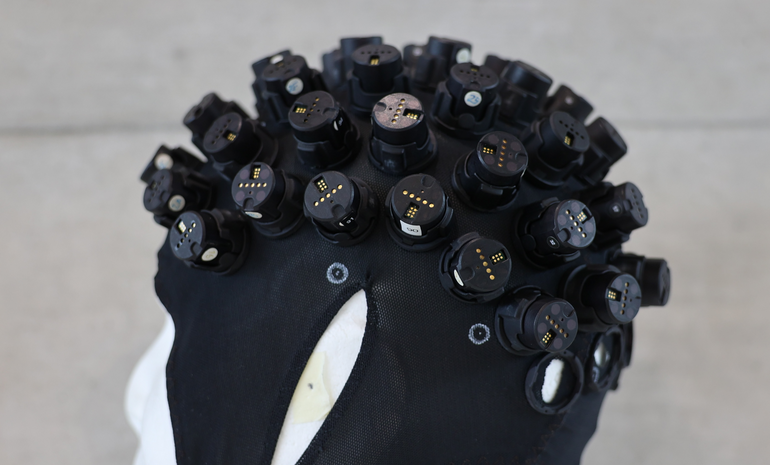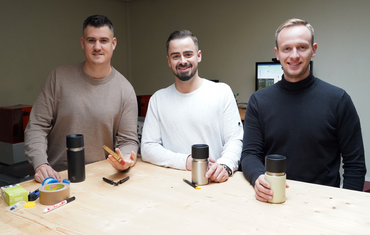At the Balgrist Campus in Zurich, Optohive is working on the future of measuring brain function. The start-up is headed up by the engineer Dominik Wyser, who’s the CEO, and the financial expert Michael Wyser, who’s the COO. “The brain is still a black box. It’s hard to believe that when you know just how important it is,” says Dominik at the beginning of our conversation. The brothers understand each other completely. “We know how the other person ticks and we have no secrets from each other,” says Michael. They also complement each other professionally. “So there was no need for the getting-to-know-each-other stage,” he laughs.
For IP professionals
This is the portal for professionals working in the field of intellectual property. Here you'll find direct access to all necessary resources.
Quick links
The brothers revolutionising brain activity measurement
The future of brain imaging could soon look very different: instead of lying down in a narrow tube, you’ll be able to put a lightweight cap on your head. This is the invention of the Zurich-based start-up Optohive. Their vision? For everyone to be able to measure brain activity and maybe even conditions like ADHD.

From ETH to a start-up
The idea came about while Dominik was writing his doctoral thesis at ETH Zurich. He was researching a method of measuring brain activity using light: fNIRS – functional near-infrared spectroscopy. This involves sending infrared rays into the brain, which show how much oxygen the blood is carrying in certain regions – and thus where activity is currently taking place.
While new therapies are constantly being developed in the area of neurorehabilitation, the brain itself is rarely measured directly. And if it is, it’s usually with an MRI scanner, which is loud, cramped, uncomfortable and very expensive too. “That’s exactly what we want to change with our invention. We want to increase availability and improve convenience at the same time,” Dominik underlines.
Sensors based on automotive technology
To achieve this, the young company uses a new optical sensor, known as a silicon photomultiplier, in an fNIRS device for brain measurement. It claims to be the first in the world to do so. “Our sensors are much more sensitive than previous systems,” explains Michael.
The technology behind the sensors was first developed in a completely different field, namely by CERN, and from there it was later adopted by the automotive industry. “The manufacturers would probably be surprised to learn what we use their sensors for,” says Dominik. “The adaptation was extremely complex from a technical point of view, but it was worth it. We can now get much more precise measurements.”

A cap for your brain
The result of this development is a cap with sensors, called the HiveOne. It’s worn on the head, collects signals and transmits them to a computer. The surface features magnetic docking points to which the sensors – known as optodes – are attached quickly and easily. This allows specific regions of the brain to be measured. “We analysed the weaknesses of previous measurement methods and developed solutions for them. For us, it was always crucial that the technology is suitable for everyday use,” say the founders.
Detecting ADHD by measuring brain activity?
A clinical study is currently underway which aims to demonstrate that ADHD can be detected via brain activity patterns – solely thanks to the wearable cap. “That would be a breakthrough for children, parents and doctors,” says Michael. Currently, there are only very subjective indicators for measuring ADHD, mainly based on questionnaires.
Beyond ADHD diagnosis, the brothers also see enormous potential in other areas, as interest in brain activity measurement is growing rapidly. Their cap could be used everywhere – privately in conjunction with all kinds of gadgets to measure brain waves, in pharmaceutical development companies or in medicine to optimise therapies.

Intellectual property (IP) protection is a key component
From the outset, the brothers attached great importance to obtaining patent protection. Optohive was able to benefit from ETH’s technology transfer programme: the university took care of the patent application and covered the costs. The patent belongs to ETH Zurich. Optohive has an exclusive licence.
“The patent is a key component – a large part of our hardware is based on it,” explains Michael. Investors value it too: “In our experience, they examine very closely whether a start-up has protected its IP.” The patent is part of their IP protection strategy: they kept some technical details deliberately secret so as not to disclose them. In addition, the company has registered a trade mark.

Running a marathon at the pace of a sprint
“It’s early days yet. Launching a start-up is like running a marathon – but at the pace of a sprint,” says Dominik. A lot has happened since the company was founded a year ago. Today, Optohive already employs 15 people, including postgraduate and undergraduate students. After a few changes, a stable team has been formed – the basis for truly revolutionising brain function measurement.



